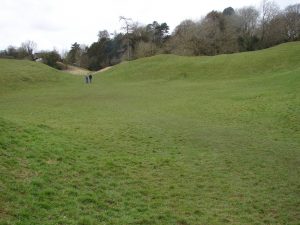 The fourth book, Templar’s Prophecy, in my Lady Apollonia West Country Mystery Series, is set in Cirencester, Gloucestershire, in the year, 1395. As with most of my books, I have set this one in a town that traces its history back to Roman times. This Roman town was more important than most people might realise today.
The fourth book, Templar’s Prophecy, in my Lady Apollonia West Country Mystery Series, is set in Cirencester, Gloucestershire, in the year, 1395. As with most of my books, I have set this one in a town that traces its history back to Roman times. This Roman town was more important than most people might realise today.
The Celts occupied Britain when the Romans invaded, but Celtic society was not organised into towns. As the Romans colonised Britain, they began with military installations on the frontier, and so it was at Corinium, the town we now call Cirencester. A Roman fort was established within a year of the Roman invasion of the island. As the Roman Legions marched westward and northward, they first moved their military forward and later began to establish more permanent settlements.
By the mid-70’s a.d., they began to build on a rectangular grid for streets that formed the town of Corinium, then known as Corinium Dobunorum for several centuries. It grew by the 2nd century to become the second largest town in Britain after Londinium. The population is estimated to have been between 10,000 and 20,000, compared to 18,000 in modern day Cirencester. The centre of the town was where the Roman Fosse Way, connecting Lincoln with Exeter, crossed Ermin Street and the roads connecting Londinium with Glevum or modern Gloucester.
Corinium was a major market town for the woollen trade in the surrounding area and was probably the administrative capital of Britannia Prima or much of what today is central England. Its basilica and forum were built on the site of the Roman fort and were second in size only to those buildings in Londinium. The amphitheatre, just outside the town and one of the largest in Britain, can still be seen today in the form of a grass-covered remnant as seen in the picture above. It plays an important role in my story. In the 14th century, it was covered with more vegetation than we see today.
The Romans abandoned Britain in the early 5th century, leading to a decline of Corinium’s fortunes which I will discuss in my next posting.
Beyond the amphitheatre, not much remains above ground from Roman Corinium. Some sections of the Roman wall still exist, especially on the northeast quadrant of the ancient city. Otherwise, the Corinium Museum in Cirencester is the best source of Roman remains. Many galleries are devoted to display of objects from the ruins and their explanation. For example, the museum has a fine collection of mosaics acquired from many archaeological digs in Cirencester.
For more on Corinium, click on
https://en.wikipedia.org/wiki/Corinium_Dobunnorum
https://coriniummuseum.org/collections/the-roman-town-of-corinium/
Tags: Chaucer's England, historical fiction, medieval mysteries